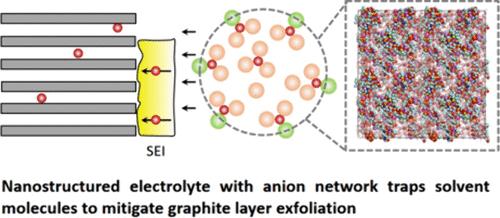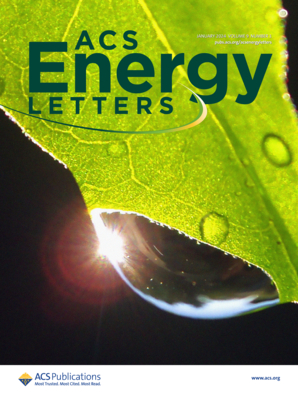Stabilizing Graphite Anode in Electrolytes with Nanoscale Anion Networking for High-Rate Lithium Storage
IF 19.3
1区 材料科学
Q1 CHEMISTRY, PHYSICAL
引用次数: 0
Abstract
Graphite is the preferred anode material in commercial lithium-ion batteries (LIBs), but its limited compatibility with various organic molecules restricts the electrolyte solvent options. The primary challenge is solvent co-intercalation with Li ions, leading to graphite layer exfoliation. As a result, electrolyte selection often relies on ethylene carbonate (EC)-based solvents. In this study, we introduce electrolytes featuring a nanoscale anion network ordering that hinders the liquid-phase exfoliation of graphite. This network, formed from concentrated long-chain lithium salts, traps free dioxolane (DOL) molecules, reducing the interactions between graphite particles and solvents during Li intercalation. Our findings reveal a mechanism that stabilizes graphite in otherwise unstable solvents with concentrated salts like LiTFSI, providing key insights for improving LIB performance by addressing electrolyte limitations on graphite anodes.

利用纳米级阴离子网络稳定电解质中的石墨负极,实现高倍率锂存储
石墨是商用锂离子电池(LIB)的首选负极材料,但它与各种有机分子的兼容性有限,限制了电解质溶剂的选择。主要的挑战是溶剂与锂离子共掺杂,导致石墨层剥离。因此,电解质的选择通常依赖于以碳酸乙烯(EC)为基础的溶剂。在本研究中,我们介绍了具有纳米级阴离子网络有序性的电解质,它能阻碍石墨的液相剥离。这种网络由浓缩的长链锂盐形成,能捕获游离的二氧戊环(DOL)分子,减少锂插层过程中石墨颗粒与溶剂之间的相互作用。我们的研究结果揭示了一种机制,这种机制能使石墨在含有 LiTFSI 等高浓度盐类的不稳定溶剂中保持稳定,为通过解决石墨阳极电解质的限制来提高 LIB 性能提供了重要的启示。
本文章由计算机程序翻译,如有差异,请以英文原文为准。
求助全文
约1分钟内获得全文
求助全文
来源期刊

ACS Energy Letters
Energy-Renewable Energy, Sustainability and the Environment
CiteScore
31.20
自引率
5.00%
发文量
469
审稿时长
1 months
期刊介绍:
ACS Energy Letters is a monthly journal that publishes papers reporting new scientific advances in energy research. The journal focuses on topics that are of interest to scientists working in the fundamental and applied sciences. Rapid publication is a central criterion for acceptance, and the journal is known for its quick publication times, with an average of 4-6 weeks from submission to web publication in As Soon As Publishable format.
ACS Energy Letters is ranked as the number one journal in the Web of Science Electrochemistry category. It also ranks within the top 10 journals for Physical Chemistry, Energy & Fuels, and Nanoscience & Nanotechnology.
The journal offers several types of articles, including Letters, Energy Express, Perspectives, Reviews, Editorials, Viewpoints and Energy Focus. Additionally, authors have the option to submit videos that summarize or support the information presented in a Perspective or Review article, which can be highlighted on the journal's website. ACS Energy Letters is abstracted and indexed in Chemical Abstracts Service/SciFinder, EBSCO-summon, PubMed, Web of Science, Scopus and Portico.
文献相关原料
| 公司名称 | 产品信息 | 采购帮参考价格 |
|---|
 求助内容:
求助内容: 应助结果提醒方式:
应助结果提醒方式:


